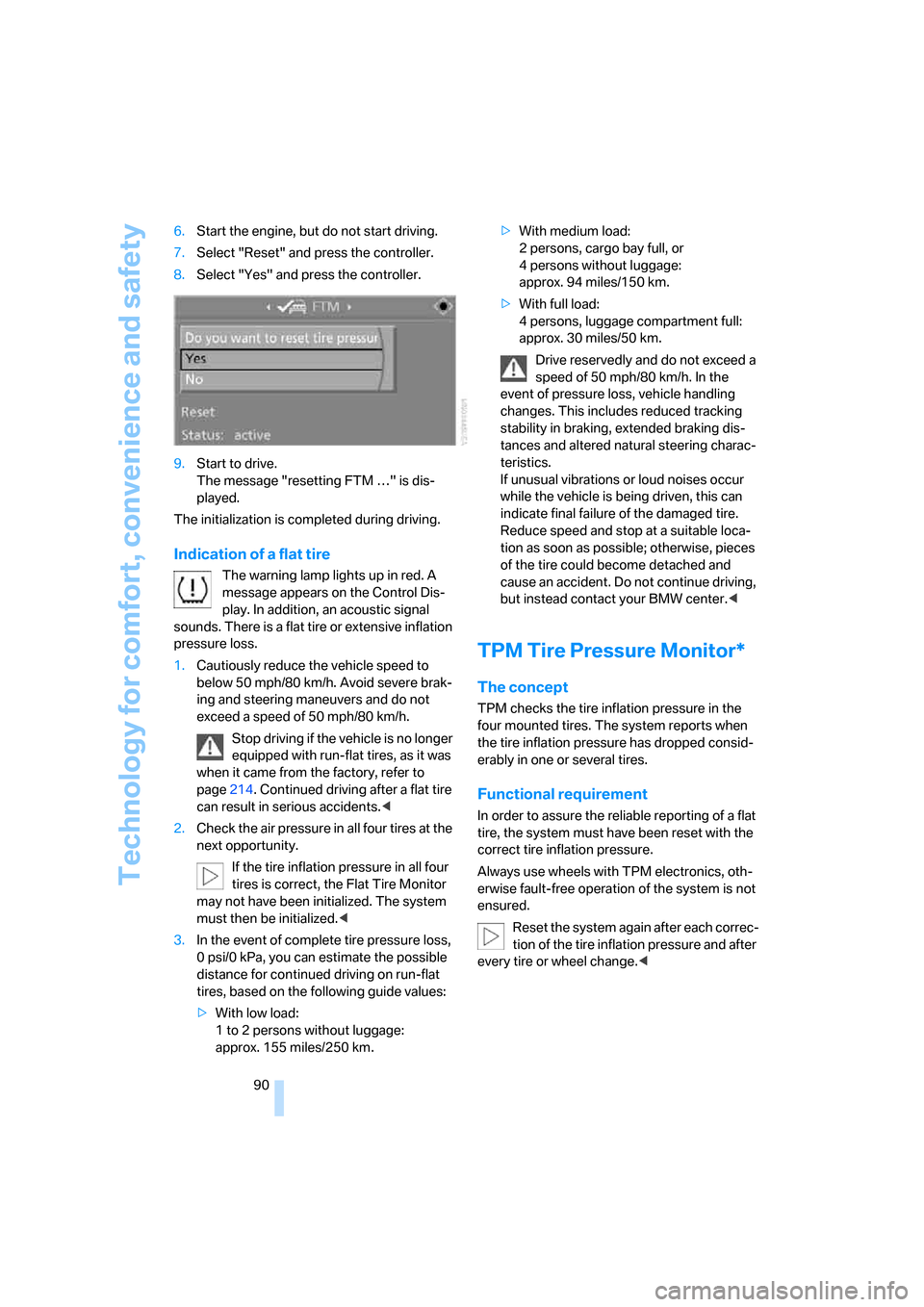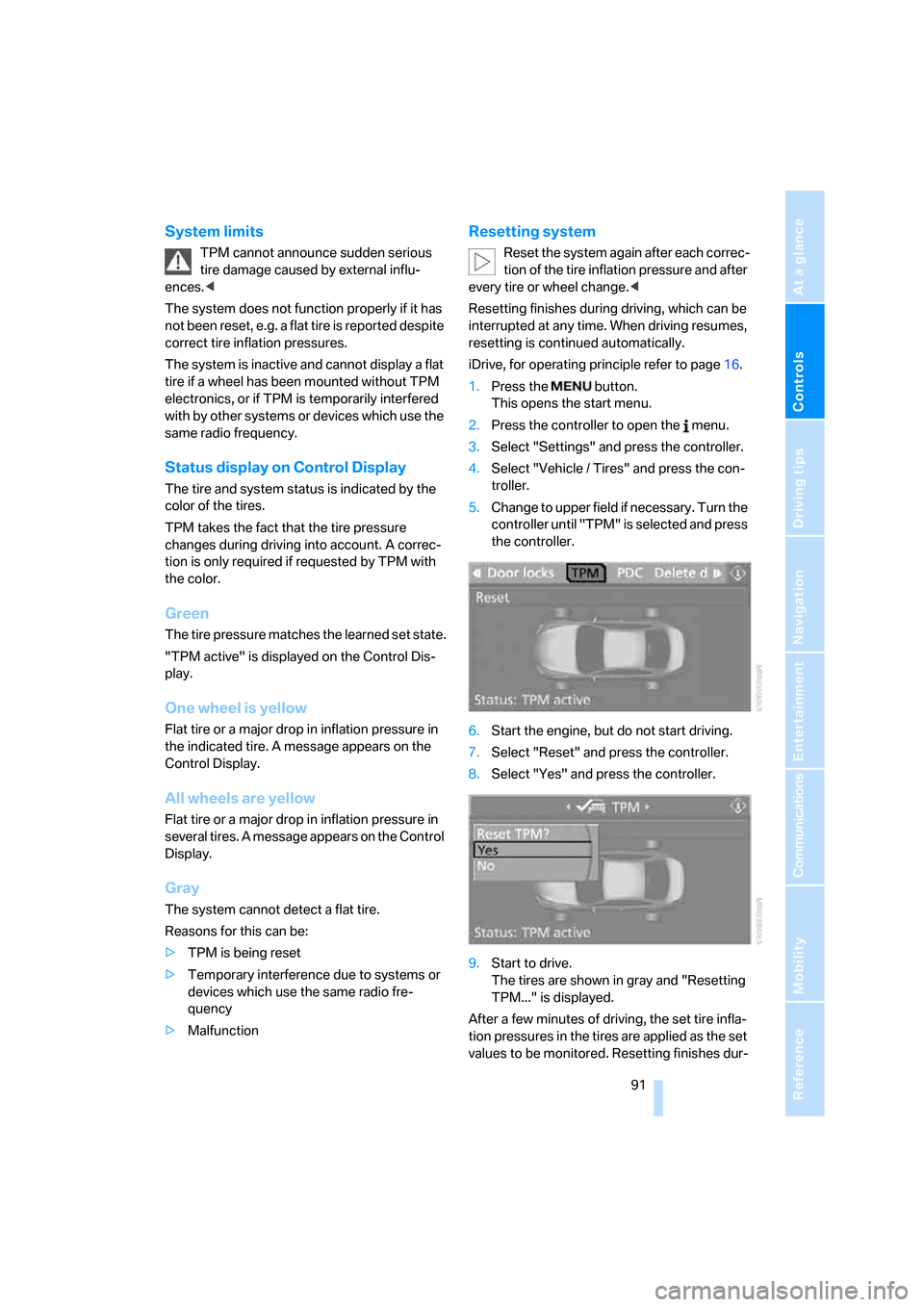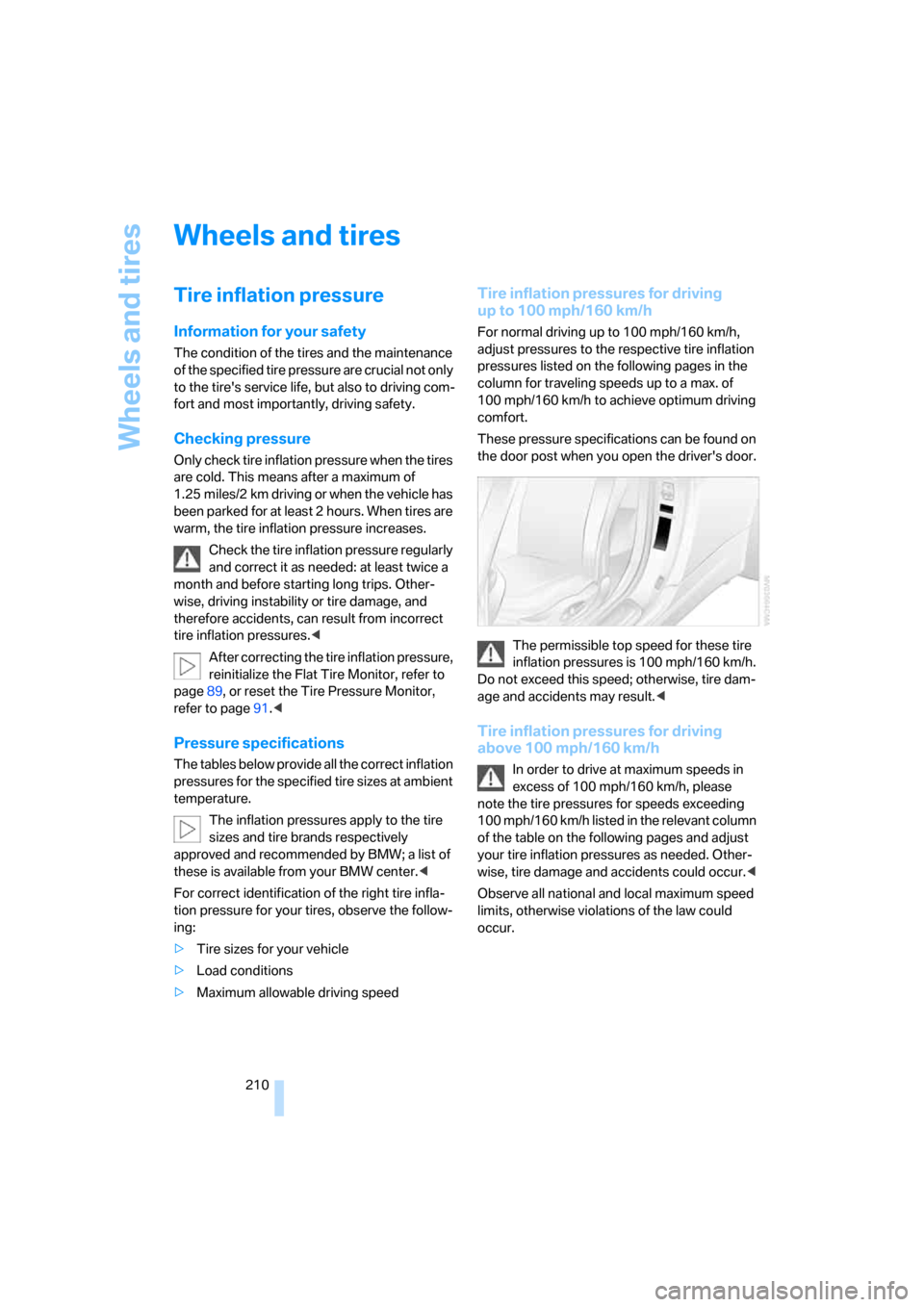2008 BMW 650I CONVERTIBLE tire pressure reset
[x] Cancel search: tire pressure resetPage 92 of 264

Technology for comfort, convenience and safety
90 6.Start the engine, but do not start driving.
7.Select "Reset" and press the controller.
8.Select "Yes" and press the controller.
9.Start to drive.
The message "resetting FTM …" is dis-
played.
The initialization is completed during driving.
Indication of a flat tire
The warning lamp lights up in red. A
message appears on the Control Dis-
play. In addition, an acoustic signal
sounds. There is a flat tire or extensive inflation
pressure loss.
1.Cautiously reduce the vehicle speed to
below 50 mph/80 km/h. Avoid severe brak-
ing and steering maneuvers and do not
exceed a speed of 50 mph/80 km/h.
Stop driving if the vehicle is no longer
equipped with run-flat tires, as it was
when it came from the factory, refer to
page214. Continued driving after a flat tire
can result in serious accidents.<
2.Check the air pressure in all four tires at the
next opportunity.
If the tire inflation pressure in all four
tires is correct, the Flat Tire Monitor
may not have been initialized. The system
must then be initialized.<
3.In the event of complete tire pressure loss,
0 psi/0 kPa, you can estimate the possible
distance for continued driving on run-flat
tires, based on the following guide values:
>With low load:
1 to 2 persons without luggage:
approx. 155 miles/250 km.>With medium load:
2 persons, cargo bay full, or
4 persons without luggage:
approx. 94 miles/150 km.
>With full load:
4 persons, luggage compartment full:
approx. 30 miles/50 km.
Drive reservedly and do not exceed a
speed of 50 mph/80 km/h. In the
event of pressure loss, vehicle handling
changes. This includes reduced tracking
stability in braking, extended braking dis-
tances and altered natural steering charac-
teristics.
If unusual vibrations or loud noises occur
while the vehicle is being driven, this can
indicate final failure of the damaged tire.
Reduce speed and stop at a suitable loca-
tion as soon as possible; otherwise, pieces
of the tire could become detached and
cause an accident. Do not continue driving,
but instead contact your BMW center.<
TPM Tire Pressure Monitor*
The concept
TPM checks the tire inflation pressure in the
four mounted tires. The system reports when
the tire inflation pressure has dropped consid-
erably in one or several tires.
Functional requirement
In order to assure the reliable reporting of a flat
tire, the system must have been reset with the
correct tire inflation pressure.
Always use wheels with TPM electronics, oth-
erwise fault-free operation of the system is not
ensured.
Reset the system again after each correc-
tion of the tire inflation pressure and after
every tire or wheel change.<
Page 93 of 264

Controls
91Reference
At a glance
Driving tips
Communications
Navigation
Entertainment
Mobility
System limits
TPM cannot announce sudden serious
tire damage caused by external influ-
ences.<
The system does not function properly if it has
not been reset, e.g. a flat tire is reported despite
correct tire inflation pressures.
The system is inactive and cannot display a flat
tire if a wheel has been mounted without TPM
electronics, or if TPM is temporarily interfered
with by other systems or devices which use the
same radio frequency.
Status display on Control Display
The tire and system status is indicated by the
color of the tires.
TPM takes the fact that the tire pressure
changes during driving into account. A correc-
tion is only required if requested by TPM with
the color.
Green
The tire pressure matches the learned set state.
"TPM active" is displayed on the Control Dis-
play.
One wheel is yellow
Flat tire or a major drop in inflation pressure in
the indicated tire. A message appears on the
Control Display.
All wheels are yellow
Flat tire or a major drop in inflation pressure in
several tires. A message appears on the Control
Display.
Gray
The system cannot detect a flat tire.
Reasons for this can be:
>TPM is being reset
>Temporary interference due to systems or
devices which use the same radio fre-
quency
>Malfunction
Resetting system
Reset the system again after each correc-
tion of the tire inflation pressure and after
every tire or wheel change.<
Resetting finishes during driving, which can be
interrupted at any time. When driving resumes,
resetting is continued automatically.
iDrive, for operating principle refer to page16.
1.Press the button.
This opens the start menu.
2.Press the controller to open the menu.
3.Select "Settings" and press the controller.
4.Select "Vehicle / Tires" and press the con-
troller.
5.Change to upper field if necessary. Turn the
controller until "TPM" is selected and press
the controller.
6.Start the engine, but do not start driving.
7.Select "Reset" and press the controller.
8.Select "Yes" and press the controller.
9.Start to drive.
The tires are shown in gray and "Resetting
TPM..." is displayed.
After a few minutes of driving, the set tire infla-
tion pressures in the tires are applied as the set
values to be monitored. Resetting finishes dur-
Page 94 of 264

Technology for comfort, convenience and safety
92 ing driving. The tires are shown in green on the
Control Display.
If a flat tire is detected during resetting
and applying the tire inflation pressures,
all tires are shown in yellow on the Control Dis-
play. The message "Tire low!" is displayed.<
Message with low tire inflation
pressure
The warning lamp lights up yellow. A
message appears on the Control Dis-
play. In addition, an acoustic signal
sounds. There is a flat tire or extensive inflation
pressure loss.
1.Cautiously reduce speed to below 50 mph/
80 km/h. Avoid sudden braking and steer-
ing maneuvers. Do not exceed a speed of
50 mph/80 km/h.
Stop driving if the vehicle is no longer
equipped with run-flat tires, as it was
when it came from the factory, refer to
page214. Continued driving after a flat tire
can result in serious accidents.<
2.In the event of complete tire pressure loss,
0 psi/0 kPa, you can estimate the possible
distance for continued driving on the basis
of the following guide values:
>With low load:
1 to 2 persons without luggage:
approx. 155 miles/250 km
>With medium load:
2 persons, cargo bay full, or
4 persons without luggage:
approx. 95 miles/150 km
>With full load:
4 persons, luggage compartment full:
approx. 30 miles/50 km
Drive reservedly and do not exceed a
speed of 50 mph/80 km/h. In the event of
pressure loss, vehicle handling changes. This
includes reduced tracking stability in braking,
extended braking distances and altered natural
steering characteristics.
If unusual vibrations or loud noises occur while
the vehicle is being driven, this can indicate final
failure of the damaged tire. Reduce speed and stop at a suitable location as soon as possible;
otherwise, pieces of the tire could become
detached and cause an accident. Do not con-
tinue driving, but instead contact your BMW
center.<
Malfunction
The yellow warning lamp flashes and
then lights up continuously. The tires
are shown in gray on the Control Dis-
play and a message is displayed. No flat tire can
be detected.
A message like this is displayed in the following
situations:
>In case of a malfunction;
have the system checked.
>If a wheels is mounted without TPM elec-
tronics.
>If TPM is temporarily interfered with by
other systems or devices which use the
same radio frequency.
Declaration according to NHTSA/
FMVSS 138 Tire Pressure Monitoring
Systems
Each tire should be checked monthly when cold
and inflated to the inflation pressure recom-
mended by the vehicle manufacturer on the
vehicle placard or tire inflation pressure label. If
your vehicle has tires of a different size than the
size indicated on the vehicle placard or tire infla-
tion pressure label, you should determine the
proper tire inflation pressure for those tires. As
an added safety feature, your vehicle has been
equipped with a tire pressure monitoring sys-
tem, TPMS, that illuminates a low tire pressure
indicator when one or more of your tires are sig-
nificantly under-inflated. Accordingly, when the
low tire pressure indicator illuminates, you
should stop and check your tires as soon as
possible, and inflate them to the proper pres-
sure. Driving on a significantly under-inflated
tire causes the tire to overheat and can lead to
tire failure. Underinflation also reduces fuel effi-
ciency and tire tread life, and may affect the
vehicle's handling and stopping ability. Please
note that the TPMS is not a substitute for
Page 212 of 264

Wheels and tires
210
Wheels and tires
Tire inflation pressure
Information for your safety
The condition of the tires and the maintenance
of the specified tire pressure are crucial not only
to the tire's service life, but also to driving com-
fort and most importantly, driving safety.
Checking pressure
Only check tire inflation pressure when the tires
are cold. This means after a maximum of
1.25 miles/2 km driving or when the vehicle has
been parked for at least 2 hours. When tires are
warm, the tire inflation pressure increases.
Check the tire inflation pressure regularly
and correct it as needed: at least twice a
month and before starting long trips. Other-
wise, driving instability or tire damage, and
therefore accidents, can result from incorrect
tire inflation pressures.<
After correcting the tire inflation pressure,
reinitialize the Flat Tire Monitor, refer to
page89, or reset the Tire Pressure Monitor,
refer to page91.<
Pressure specifications
The tables below provide all the correct inflation
pressures for the specified tire sizes at ambient
temperature.
The inflation pressures apply to the tire
sizes and tire brands respectively
approved and recommended by BMW; a list of
these is available from your BMW center.<
For correct identification of the right tire infla-
tion pressure for your tires, observe the follow-
ing:
>Tire sizes for your vehicle
>Load conditions
>Maximum allowable driving speed
Tire inflation pressures for driving
up to 100 mph/160 km/h
For normal driving up to 100 mph/160 km/h,
adjust pressures to the respective tire inflation
pressures listed on the following pages in the
column for traveling speeds up to a max. of
100 mph/160 km/h to achieve optimum driving
comfort.
These pressure specifications can be found on
the door post when you open the driver's door.
The permissible top speed for these tire
inflation pressures is 100 mph/160 km/h.
Do not exceed this speed; otherwise, tire dam-
age and accidents may result.<
Tire inflation pressures for driving
above 100 mph/160 km/h
In order to drive at maximum speeds in
excess of 100 mph/160 km/h, please
note the tire pressures for speeds exceeding
100 mph/160 km/h listed in the relevant column
of the table on the following pages and adjust
your tire inflation pressures as needed. Other-
wise, tire damage and accidents could occur.<
Observe all national and local maximum speed
limits, otherwise violations of the law could
occur.
Page 256 of 264

Everything from A to Z
254 Presetting parked car
ventilation activation
times113
Pressure, tires210
Pressure monitoring of tires,
refer to TPM Tire Pressure
Monitor90
"Profile"205
Programmable buttons on
steering wheel55
Programmable memory
buttons21
Protective function, refer to
Pinch protection system
– glass sunroof41
– windows40
R
Radiator fluid, refer to
Coolant219
Radio
– Autostore164
– controls158
– High Definition Radio166
– sampling stations163
– satellite radio169
– selecting frequency
manually163
– selecting
waveband158,162
– station search163
– station selection162
– station with best
reception164
– storing stations164
– switching on/off158
– tone control159
– volume159
– Weather Band, refer to
Weather news flashes166
Radio key, refer to Keys/
remote control28
Radio position, refer to Radio
readiness58Radio readiness58
– switched off59
– switched on58
– with comfort access37
Radio stations, storing164
Rain sensor, windshield wiper
system64
"Random", random play
sequence175
"Random all" in audio
mode176
"Random directory" in audio
mode175
Random play sequence
– CD changer175
– CD player175
"RDS"165
Reading lamps107
Rear lamps, refer to Tail
lamps224
Rearview mirrors, refer to
Mirrors53
Rear window
– heating110
– opening and closing39
"Received calls"192
Reception
– quality165
– radio stations165
– regional station164
Reception quality of mobile
phone, refer to Status
information20
Rechargeable flashlight117
Recirculated-air mode, refer
to AUC Automatic
recirculated-air control111
Recirculation of air, refer to
AUC Automatic
recirculated-air control111
Reclining seat, refer to
Seats48
Recording times, refer to
Stopwatch82
"Redial" for mobile phone192
Redialing with mobile
phone197Reflectors, refer to Tail
lamps224
Refueling208
Releasing
– hood216
– locks, refer to Unlocking37
"Relock door if not
opened"33
Remaining distance, refer to
Cruising range75
Remaining distance to
destination, refer to
Computer76
Remote control28
– battery replacement38
– comfort access36
– garage-door opener115
– luggage compartment lid31
– malfunction31,38
Removing condensation from
windows110
"Repeat directory" in audio
mode175
"Repeat" in audio mode175
"Repeat track" in audio
mode175
Replacement fuses226
Replacement remote control,
refer to New remote
controls28
Replacing bulbs, refer to
Lamps and bulbs223
Replacing tires, changing a
wheel225
Reporting safety defects7
Required fuel209
Reserve warning, refer to Fuel
gauge75
"Reset"90,91
– stopwatch82
– tone settings161
Reset, refer to Resetting tone
settings161
Residual heat112
Restraint systems
– for children56
– refer to Safety belts52
Page 260 of 264

Everything from A to Z
258 Torque, refer to Engine
data234
Touch tone dialing, refer to
Tone dialing method194
Tow bar230
Tow fitting229
Towing229
– methods230
– tow fittings229
– with manual
transmission230
– with Sport automatic
transmission230
"Town / City" for destination
entry135
Tow rope231
Tow-starting229
"TPM"91
TPM Tire Pressure
Monitor90
– resetting system91
– system limits91
– warning lamp92
Tracks
– finding174
– random sequence175
– sampling on CD174
– selecting with CD173
Track width, refer to
Dimensions235
Traction-assist feature, refer
to DSC Dynamic Stability
Control87
Traction control, refer to DSC
Dynamic Stability
Control87
Traffic congestion
– displaying traffic
information150
– refer to Bypassing route
sections150
Traffic information for
navigation150
– depiction in route map152
– displaying151
– during destination
guidance153
– symbols152"Traffic Info settings"151
Transmission
– manual transmission60
– sport automatic
transmission60
– starting assistant88
– towing230
– transmission lock, manually
locking and unlocking, sport
automatic transmission62
Transporting children
safely56
Transport securing device,
refer to Securing cargo128
Tread depth, refer to Minimum
tread depth
213
Treble, refer to Tone
control159
"Treble", tone control159
"Trip computer"77
Trip computer76
Trip-distance counter
– refer to Trip computer76
– refer to Trip meter74
"Triple turn signal"64
Trip meter, also refer to Trip
computer76
Trip odometer74
Trunk, refer to Luggage
compartment35
Trunk lid, refer to Luggage
compartment lid34
Turning circle, refer to
Dimensions235
Turn signals63
U
Undercarriage protection,
refer to Caring for your
vehicle brochure
Uniform Tire Quality Grading/
UTQR212
"Units"84
Units
– average fuel
consumption84
– temperature84Universal garage-door
opener, refer to Integrated
universal remote
control115
Universal remote control, refer
to Integrated universal
remote control115
"Unlock button"30
Unlocking
– from inside33
– from outside30
– without key, refer to Comfort
access36
"Update services"203
USB/audio interface179
"USB" in audio mode180
"Use current location as
address"142,144
Used batteries
– refer to Disposal225
– refer to Replacing battery38
Using turn signals63
V
Vehicle
– battery225
– breaking-in124
– care, refer to Caring for your
vehicle brochure
– cargo loading127
– measurements, refer to
Dimensions235
– parking59
– washing, refer to Caring for
your vehicle brochure
– weights237
"Vehicle / Tires" for
unlocking30
Vehicle jack225
– jacking points225
Vehicle position, refer to
Displaying current
position153
Ventilation112
– draft-free112
– for cooling112
– parked car ventilation112